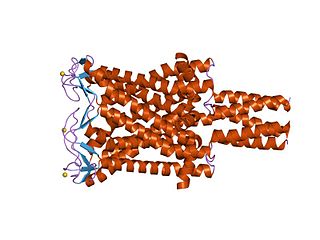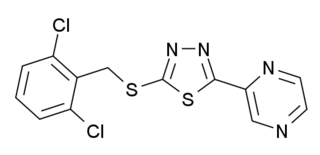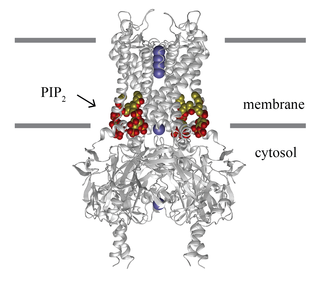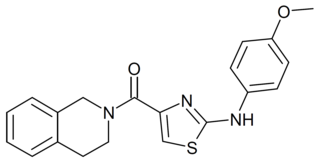
A dorsal root ganglion is a cluster of neurons in a dorsal root of a spinal nerve. The cell bodies of sensory neurons known as first-order neurons are located in the dorsal root ganglia.

Hereditary stomatocytosis describes a number of inherited, mostly autosomal dominant human conditions which affect the red blood cell and create the appearance of a slit-like area of central pallor (stomatocyte) among erythrocytes on peripheral blood smear. The erythrocytes' cell membranes may abnormally 'leak' sodium and/or potassium ions, causing abnormalities in cell volume. Hereditary stomatocytosis should be distinguished from acquired causes of stomatocytosis, including dilantin toxicity and alcoholism, as well as artifact from the process of preparing peripheral blood smears.

Pannexins are a family of vertebrate proteins identified by their homology to the invertebrate innexins. While innexins are responsible for forming gap junctions in invertebrates, the pannexins have been shown to predominantly exist as large transmembrane channels connecting the intracellular and extracellular space, allowing the passage of ions and small molecules between these compartments.

Large conductance mechanosensitive ion channels (MscLs) (TC# 1.A.22) are a family of pore-forming membrane proteins that are responsible for translating stresses at the cell membrane into an electrophysiological response. MscL has a relatively large conductance, 3 nS, making it permeable to ions, water, and small proteins when opened. MscL acts as stretch-activated osmotic release valve in response to osmotic shock.

Potassium channel subfamily K member 2, also known as TREK-1, is a protein that in humans is encoded by the KCNK2 gene.

Potassium channel subfamily K member 4 is a protein that in humans is encoded by the KCNK4 gene. KCNK4 protein channels are also called TRAAK channels.
Mechanosensation is the transduction of mechanical stimuli into neural signals. Mechanosensation provides the basis for the senses of light touch, hearing, proprioception, and pain. Mechanoreceptors found in the skin, called cutaneous mechanoreceptors, are responsible for the sense of touch. Tiny cells in the inner ear, called hair cells, are responsible for hearing and balance. States of neuropathic pain, such as hyperalgesia and allodynia, are also directly related to mechanosensation. A wide array of elements are involved in the process of mechanosensation, many of which are still not fully understood.
Mechanosensitive channels (MSCs), mechanosensitive ion channels or stretch-gated ion channels are membrane proteins capable of responding to mechanical stress over a wide dynamic range of external mechanical stimuli. They are present in the membranes of organisms from the three domains of life: bacteria, archaea, and eukarya. They are the sensors for a number of systems including the senses of touch, hearing and balance, as well as participating in cardiovascular regulation and osmotic homeostasis (e.g. thirst). The channels vary in selectivity for the permeating ions from nonselective between anions and cations in bacteria, to cation selective allowing passage Ca2+, K+ and Na+ in eukaryotes, and highly selective K+ channels in bacteria and eukaryotes.
TRPN is a member of the transient receptor potential channel family of ion channels, which is a diverse group of proteins thought to be involved in mechanoreception. The TRPN gene was given the name no mechanoreceptor potential C (nompC) when it was first discovered in fruit flies, hence the N in TRPN. Since its discovery in fruit flies, TRPN homologs have been discovered and characterized in worms, frogs, and zebrafish.
Small conductance mechanosensitive ion channels (MscS) provide protection against hypo-osmotic shock in bacteria, responding both to stretching of the cell membrane and to membrane depolarization. In eukaryotes, they fulfill a multitude of important functions in addition to osmoregulation. They are present in the membranes of organisms from the three domains of life: bacteria, archaea, fungi and plants.
In molecular biology mir-365 microRNA is a short RNA molecule. MicroRNAs function to regulate the expression levels of other genes by several mechanisms.

Piezo-type mechanosensitive ion channel component 1 is a protein that in humans is encoded by the PIEZO1 gene. PIEZO1 is a large mechanosensitive ion channel protein that forms a homotrimeric complex with a distinctive three-bladed, propeller-shaped architecture. Each subunit of PIEZO1 contains between 30 and 40 transmembrane domains. The protein consists of a central pore module and peripheral mechanotransduction modules. The pore module is composed of the last two transmembrane helices, an extracellular cap domain, and an intracellular C-terminal domain.

Piezo-type mechanosensitive ion channel component 2 is a protein that in humans is encoded by the PIEZO2 gene. It has a homotrimeric structure, with three blades curving into a nano-dome, with a diameter of 28 nanometers.

Yoda1 is a chemical compound which is the first agonist developed for the mechanosensitive ion channel PIEZO1. This protein is involved in regulation of blood pressure and red blood cell volume, and Yoda1 is used in scientific research in these areas.

Lipid-gated ion channels are a class of ion channels whose conductance of ions through the membrane depends directly on lipids. Classically the lipids are membrane resident anionic signaling lipids that bind to the transmembrane domain on the inner leaflet of the plasma membrane with properties of a classic ligand. Other classes of lipid-gated channels include the mechanosensitive ion channels that respond to lipid tension, thickness, and hydrophobic mismatch. A lipid ligand differs from a lipid cofactor in that a ligand derives its function by dissociating from the channel while a cofactor typically derives its function by remaining bound.

GSK417651A is a chemical compound which acts as a blocker of the TRPC family of calcium channels, with selectivity for the TRPC3 and TRPC6 subtypes. It has been used to investigate the role of TRPC3/6 channels in heart function.

ML-SA1 is a chemical compound which acts as an "agonist" of the TRPML family of calcium channels. It has mainly been studied for its role in activating TRPML1 channels, although it also shows activity at the less studied TRPML2 and TRPML3 subtypes. TRPML1 is important for the function of lysosomes, and ML-SA1 has been used to study several disorders resulting from impaired lysosome function, including mucolipidosis type IV and Niemann-Pick's disease type C, as well as other conditions such as stroke and Alzheimer's disease.

ML2-SA1 (EVP-22) is a chemical compound which acts as an "agonist" for the TRPML2 calcium channel, with high selectivity for TRPML2 and no significant activity at the related TRPML1 and TRPML3 channels. It has been used to demonstrate the role of TRPM2 in immune system function, both triggering release of the chemokine CCL2 from macrophages and stimulating macrophage migration and endolysosomal trafficking.

Grammostola mechanotoxin #4, also known as M-theraphotoxin-Gr1a (M-TRTX-Gr1a), is a neurotoxin isolated from the venom of the spider Chilean rose tarantula Grammostola spatulate. This amphiphilic peptide, which consists of 35 amino acids, belongs to the inhibitory cysteine knot (ICK) peptide family. It reduces mechanical sensation by inhibiting mechanosensitive channels (MSCs).

Jedi1 is a chemical compound which acts as an agonist for the mechanosensitive ion channel PIEZO1, and is used in research into the function of touch perception.
















